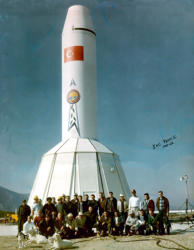HISTORY - Page 57
housed the propellant and served as the combustion chamber, a pyrogen unit for engine ignition, a nozzle,
and a thrust termination device. Unlike the main engine, all components formed one unit. In operation,
the vernier engine ignited two seconds after separation from the main thrust unit. The vernier unit then
propelled the missile body until the desired velocity was attained, and when this requirement was
satisfied, cutoff occurred. Squibs were used for the thrust termination device, and the engine nozzle was
blown away
75
.
Although the two foregoing units were the major portion of the propulsion system, other devices, already
discussed in part, were equally important in solving the target range problem. These included a missile roll
control system, and a spatial attitude control system.
NAA delivered its first nonflyable main engine to ABMA in July 1956, and the Agency began a static test
program in September. At first, the tests progressed smoothly with a number of static firings lasting for
several seconds; but, by November, four thrust chambers had burned out, causing delay while ABMA and
NAA were investigating the problem. Strengthening modifications to the thrust chamber eliminated the
difficulty, and in January 1957 the static testing program was progressing satisfactorily
76
.
ABMA received its first flyable engine in September 1956; and, during inspection, a number of design
deficiencies were noted. Within a short time—November—the second engine was delivered. Both of the
_____________________________







(75) ABMA Rpt DSD-TR-4-60, Vernier Engine Operation, 21 Jan 60, Hist Off files.
(76) JUP Dev Plan, FY 58, 29 Sep 56; JUP Prog Rpt for Nov 56, 8 Dec 56; JUP Prog Rpt for Jan 57, 8 Feb 57, Hist Off files.



Jupiter SM-78 Weapon System
I&C Team 2, Çigli AB, Turkey 1961-1962 Chrysler Corporation Missile Division

HISTORY - Page 57
housed the propellant and served as the combustion
chamber, a pyrogen unit for engine ignition, a nozzle,
and a thrust termination device. Unlike the main
engine, all components formed one unit. In operation,
the vernier engine ignited two seconds after
separation from the main thrust unit. The vernier unit
then propelled the missile body until the desired
velocity was attained, and when this requirement was
satisfied, cutoff occurred. Squibs were used for the
thrust termination device, and the engine nozzle was
blown away
75
.
Although the two foregoing units were the major
portion of the propulsion system, other devices,
already discussed in part, were equally important in
solving the target range problem. These included a
missile roll control system, and a spatial attitude
control system.
NAA delivered its first nonflyable main engine to
ABMA in July 1956, and the Agency began a static test
program in September. At first, the tests progressed
smoothly with a number of static firings lasting for
several seconds; but, by November, four thrust
chambers had burned out, causing delay while ABMA
and NAA were investigating the problem.
Strengthening modifications to the thrust chamber
eliminated the difficulty, and in January 1957 the static
testing program was progressing satisfactorily
76
.
ABMA received its first flyable engine in September
1956; and, during inspection, a number of design
deficiencies were noted. Within a short
time—November—the second engine was delivered.
Both of the
_____________________________
(75) ABMA Rpt DSD-TR-4-60, Vernier Engine Operation, 21 Jan 60, Hist Off files.
(76) JUP Dev Plan, FY 58, 29 Sep 56; JUP Prog Rpt for Nov 56, 8 Dec 56; JUP Prog Rpt for Jan 57,
8 Feb 57, Hist Off files.





















